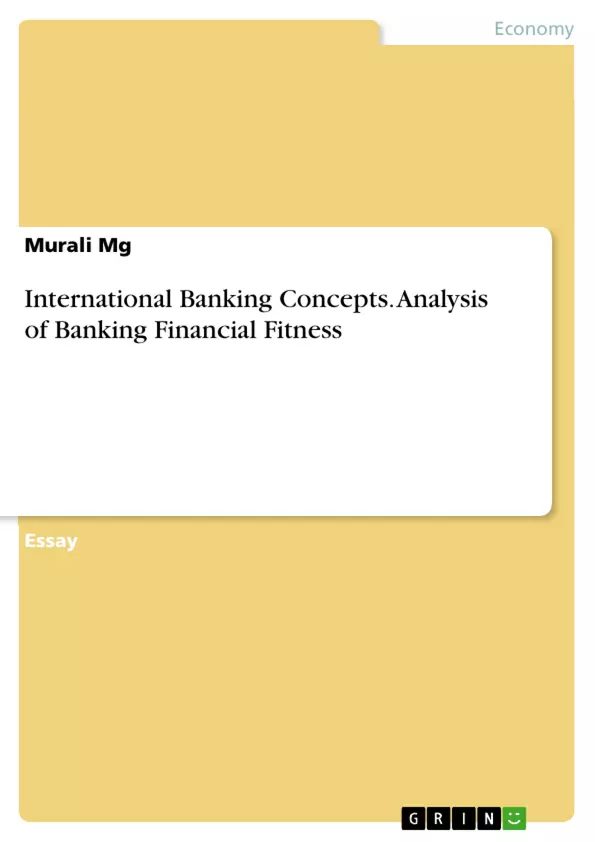International Banking can be defined as banking transactions crossing national boundaries. The activities involves like international lending; claims of domestic bank offices on foreign residents, claims of foreign bank offices on local residents, claims of domestic bank offices on domestic residents in foreign currency are the major activities involved in International Banking.
The evolution of banking history dates back to 2000 BC in Assyria and Babylonia; while the modern banking systems originated in Renaissance Italy. The major incentive for the growth of international banking was migration of domestic customers who were MNE’s growing foreign activities and the impacts of regulatory differences. The report is comprised of Liquidity risks, market risks, credit risks of Standard Chartered Bank Plc. The company also demonstrates the firm efficiency of the firm using CAMEL RATING SCALE. The overview of the analysis states that the firm is operating proficiently under the guidelines of BASEL.
Table of Contents
- Executive Summary
- Company Profile- Brief Overview
- Consumer Banking
- Liquidity Risk
- Measuring Liquidity Risk-SCB
- Measuring Credit Risk Exposure
- Market Rate Risk
- Value at Risk (VAR)
- CAMEL Rating System
Objectives and Key Themes
The objective of this report is to analyze the liquidity, credit, and market risks of Standard Chartered Bank Plc (SCB), and to assess the bank's efficiency using the CAMEL rating system. The report explores the evolution of international banking, the strategic decisions of SCB, and its global organizational structure.
- International Banking Activities and Growth
- Risk Management Strategies of SCB
- SCB's Organizational Structure and Global Operations
- Efficiency Assessment using CAMEL Rating
- Regulatory Compliance
Chapter Summaries
Executive Summary: This section provides a brief overview of the report, defining international banking and highlighting the key areas of analysis: liquidity, credit, and market risks of Standard Chartered Bank Plc, along with an assessment of the bank's efficiency using the CAMEL rating system. It emphasizes the bank's proficiency in operating within Basel guidelines.
Company Profile- Brief Overview: This chapter introduces Standard Chartered Bank, tracing its history from its founding in 1853 to its current status as a major international bank with a significant presence in Asia, Africa, and the Middle East. It details the bank's major acquisitions since 2008, its global workforce, financial performance (2012 revenue and net income), and its core service offerings (consumer banking, corporate banking, investment banking, mortgage, and wealth management). The organizational structure is described as a divisional structure globally, with some regional variations to a matrix structure. Specific departments and their functions are described, including consumer banking, wholesale banking, global markets, international banking, trust department, offshore banking, securities, internal audit, human resources, group technology & operations, legal compliance, and corporate affairs. The chapter concludes by noting Standard Chartered Bank's incorporation in England and its global branch network.
Consumer Banking: This section focuses on SCB's consumer banking division, detailing its service offerings to individual, private, premium, and SME customers. It emphasizes the bank's customer-focused approach and its strategy of providing customized financial products and services to meet diverse customer needs.
Keywords
International Banking, Standard Chartered Bank, Liquidity Risk, Credit Risk, Market Risk, CAMEL Rating System, Risk Management, Organizational Structure, Consumer Banking, Basel Accords, Global Operations.
Standard Chartered Bank Plc Risk Analysis Report: Frequently Asked Questions
What is the purpose of this report?
This report analyzes the liquidity, credit, and market risks of Standard Chartered Bank Plc (SCB) and assesses its efficiency using the CAMEL rating system. It also explores the bank's evolution, strategic decisions, and global organizational structure.
What topics are covered in the report?
The report covers a range of topics, including international banking activities and growth, SCB's risk management strategies, its organizational structure and global operations, efficiency assessment using the CAMEL rating, and regulatory compliance. Specific areas of focus include the bank's consumer banking division, its approach to liquidity, credit, and market risk management, and details on its global operations.
What is the structure of the report?
The report is structured with an executive summary, a company profile (including a detailed look at consumer banking), sections on liquidity risk, credit risk exposure, market rate risk, and Value at Risk (VAR), a discussion of the CAMEL rating system, and a conclusion summarizing key findings. The report also includes a table of contents and a list of keywords.
What is the scope of the company profile?
The company profile provides a comprehensive overview of Standard Chartered Bank, including its history, major acquisitions, global workforce, financial performance (revenue and net income from 2012), core service offerings (consumer banking, corporate banking, investment banking, mortgage, and wealth management), organizational structure (described as divisional with some regional variations to a matrix structure), and its global branch network. Specific departments and their functions are also detailed.
What aspects of risk are analyzed?
The report analyzes liquidity risk, credit risk, and market risk, including methods of measuring these risks within SCB and using metrics such as Value at Risk (VAR).
How is the bank's efficiency assessed?
The bank's efficiency is assessed using the CAMEL rating system, a widely used framework for evaluating the financial health and soundness of banks.
What are the key takeaways from the executive summary?
The executive summary provides a concise overview of the report's findings, highlighting the bank's proficiency in navigating Basel guidelines and its performance across key risk areas.
What are the key words associated with this report?
Key words include: International Banking, Standard Chartered Bank, Liquidity Risk, Credit Risk, Market Risk, CAMEL Rating System, Risk Management, Organizational Structure, Consumer Banking, Basel Accords, and Global Operations.
What is the intended audience for this report?
This report is intended for academic use, facilitating the analysis of themes related to international banking, risk management, and organizational structure in a structured and professional manner.
- Citar trabajo
- Murali Mg (Autor), 2014, International Banking Concepts. Analysis of Banking Financial Fitness, Múnich, GRIN Verlag, https://www.grin.com/document/301477



